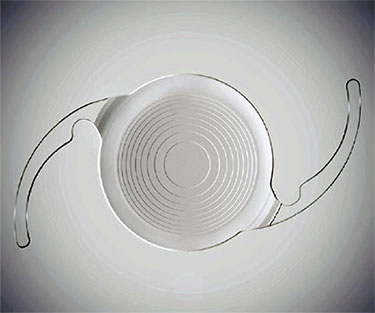- Home
- Resource Library
- IOL (Intraocular lens) & ICL (Implantable contact lens)
- Johnson & Johnson Tecnis Symfony Plus IOL
Johnson & Johnson Tecnis Symfony Plus IOL

Tecnis Symfony Plus IOLs
We wanted to share with you an article from the April 2020 edition of Cataract & Refractive Surgery Today. Dr. Kerry Assil contributes an article about technologies, “In the Pipeline.” In this article, he talks about the Tecnis Symfony Plus, an IOL with novel advances, including a violet light blocker.
The Tecnis Symfony Plus (Johnson & Johnson Vision) is the first presbyopia-correcting extended depth of focus IOL. It delivers a continuous full range of high-quality vision while correcting issues that have typically been associated with traditional multifocal IOLs.
In the pipeline, discover more about some of the IOL technologies that are in clinical trials.
Modeled on the EDOF Tecnis Symfony (Figure 11), the Plus offers three advantages: (1) stronger near vision by about 1 line of near visual acuity, so that patients can read finer print, (2) a reduced level of dysphotopsia and (3) the addition of a violet-light–blocking chromophore intended to compress chromatic aberration. The latter could reduce dysphotopsia, improve contrast acuity, and provide further retinal protection.

Blocking harmful ultraviolet light
All IOLs block harmful invisible UV light rays. Violet light is scattered more easily than light of other colors due to its short wavelength and high energy.1,2
Today, we are all exposed to more short-wavelength light due to high-efficiency light-emitting diodes (LEDs) in our smartphone screens, automobile headlights, and light bulbs. Because violet and blue light fall on the short end of the visible light spectrum, they are often grouped, but there are important differences. Violet light (360 to 450 nm) has been associated with oxidative stress and retinal cell damage, whereas blue light (450 to 500 nm) has not been credibly associated with retinal damage and has beneficial characteristics, including helping to regulate circadian rhythm and to preserve image quality in low light.4
A violet-blocking chromophore is already used in IOLs outside the United States. In comparison with clear IOLs, significantly more patients with violet light–filtering IOLs experienced no difficulties driving in the daytime (P = .033) or at night (P = .017), and significantly more experienced no frustration with vision (89.8% vs. 79.8%).5 Johnson & Johnson Vision researchers have found a 29% reduction in halo intensity from xenon headlights and a 13% reduction in halo intensity from smartphone LED light with these lenses compared to colorless IOLs.6 This validates the expectation that blocking short-wavelength violet light would improve image quality.
In conclusion
The Tecnis Symfony lens is the only presbyopia-correcting IOL on the market that approaches the distance clarity and contrast acuity of a monofocal IOL. How the Symfony Plus lens fits into our armamentarium of presbyopia-correcting IOLs will depend on the near and distance vision results we obtain clinically. When I had the opportunity to evaluate the Tecnis Symfony Plus in a multicenter study, I found that the improvement in near vision compared with the Symfony was large, and any reduction in distance acuity, if present, appeared subclinical. My patients noted fewer dysphotopsias. In my early experience, patient satisfaction with the lens was extremely high.
Time will tell whether Tecnis Symfony Plus achieves the same distance acuity benchmark and thus replaces Tecnis Symfony in our practice or whether the two are complementary, either in a personalized mix-and-match scenario or through patient selection.
Have questions about the Johnson & Johnson Tecnis Symfony Plus IOL or any other IOL?
The Assil Gaur Eye Institute’s nationally known ophthalmologists select the highest quality intraocular lenses for cataract patients based on their visual needs and lifestyles. Our cataract surgeons are equipped with the latest technology to assess your eye health and vision needs and select the best IOL for your needs.
In keeping with the founding principles of AGEI, our eye surgeons have managed to keep their clinics comfortable and familiar, much like how family-run medical practices used to be.
Please call (866) 945-2745 or make an appointment online.
We are conveniently located for patients throughout Southern California and the Los Angeles area in or near Beverly Hills, Santa Monica, West Los Angeles, West Hollywood, Culver City, Hollywood, Venice, Marina del Rey, Malibu, Manhattan Beach, and Downtown Los Angeles.
In addition to outpatient laser cataract surgery, the ophthalmology experts at AGEI are nationally recognized for their eye care and treatment options for a full range of conditions, including glaucoma, retinal detachment, cornea conditions, floaters and flashes, dry eye, presbyopia, refractive surgery such as LASIK and much more.
Sources
1. University of Arizona College of Optical Sciences (2013) Ocular scatter. https://wp.optics.arizona.edu/visualopticslab/wpcontent/uploads/sites/52/2016/08/Class10_11.pdf
2. Tosini G, Ferguson I, Tsubota K. Effects of blue light on the circadian system and eye physiology. Mol Vis. 2016;22:61-72.
3. Marie M, Bigot K, Angebault C, et al. Light action spectrum on oxidative stress and mitochondrial damage in A2E-loaded retinal pigment epithelium cells. Cell Death Dis. 2018;9(3):287.
4. Mainster MA. Violet and blue light blocking intraocular lenses: photoprotection versus photoreception. Br J Ophthalmol. 2006;90(6):784-792.
5. Canovas C, Weeber H, Trentacost D, et al. Optical and visual performance of violet blocking intraocular lenses. Poster presented at: Association for Research in Vision and Ophthalmology Annual Meeting; April 28-May 2, 2019; Vancouver, Canada.
6. Data on file with Johnson & Johnson Vision.
Read the original article on Cataract & Refractive Surgery Today.














